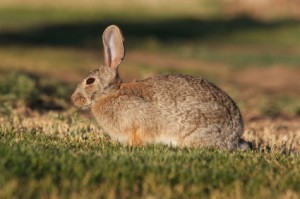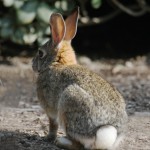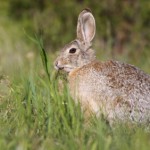Family, Description and Size:
The Cottontail rabbit is one of the 16 species of lagomorpha found in the Americas.
They closely resemble the wild European Rabbit. Cottontail rabbits get their name from the white color on the underside of their stubby tail that shows when they flee. Their coat is usually of brownish-gray or silvery-gray color, they have long ears and are usually of a small build.
In the wild, cottontail rabbits usually span an average of 15.5 to 18.75 inches and weigh 28 to 54 oz.
Range and Habits:
The cottontail rabbit live through-out North America, with larger populations occurring mostly in the eastern region of North America. They prefer habitats that border farms, deserts and prairies. They prefer brushy areas and will often be found on the edge of thick cover, which provides a quick escape. Cottontail rabbits are most found in thick bushy areas such as coulees, river bottoms, sage-brush plains and abandoned farmsteads.
As herbivores, they enjoy garden and agricultural foods such as peas and leafy greens and will often ruin crops to satiate their hunger. If no such crops can be found they will graze on grasses and small plants. During the winter they will feed on bark, twigs and buds. If rabbits feed on the bark of young trees, or saplings, they will affect growth and often-times kill the trees.
General Information:
Cottontail rabbits are mostly active during the night. They stay hidden during daylight hours, usually in high vegetation. If spotted by a predator they will run in a zigzag pattern to avoid being caught, reaching speeds of 18 miles an hour with ease.
The females give birth in shallow nests to very helpless young of whom a mere 15% survives the first year of their life. The rabbits make up for this by breeding three to four times a year, producing from three up to eight young each time. After three to four weeks the young are self-sufficient and after two months they start breeding. This can cause the cottontail rabbit population to boom in areas where no predators are to be found, like farms. In turn, such great population can be detrimental to the farm.
Cottontail rabbits are excellent game and can be consumed by humans as long as they were not killed by poison. It is not rare that a farmer whose crops were eaten by rabbits will proceed to consume the rabbits themselves.
Predators, Mortality and Lifespan:
Cottontail rabbits are among the favorite prey of bobcats, coyotes, foxes and other predators fast enough to catch them. When their population grows out of control near farmlands, the cottontail
rabbits are often hunted down to a reasonable number by licensed hunters. Cottontail rabbits are the most popular small game animal in North America to hunt due to the animal’s range, abundant numbers and rapid reproduction rate.
Even though disease, famine and road accidents kill a great number of cottontail rabbits throughout the year, the species enjoys a healthy population and is on the least concern list of endangered animals.
A cottontail rabbit will live three years on average in the wild.






[…] For more information on the Cottontail Rabbit, visit our Cottontail Varmint Information Page. […]
[…] For more information on the Cottontail Rabbit, visit our Cottontail Varmint Information Page. […]